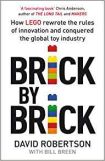Brick by Brick: How LEGO Rewrote the Rules of Innovation and Conquered the Global Toy Industry by David Robertson and Bill Breen
| Brick by Brick: How LEGO Rewrote the Rules of Innovation and Conquered the Global Toy Industry by David Robertson and Bill Breen | |
|
| |
| Category: Business and Finance | |
| Reviewer: John Van der Kiste | |
| Summary: A study of the near-crash of LEGO in 2003 and its strategy for subsequent recovery. | |
| Buy? Maybe | Borrow? Yes |
| Pages: 304 | Date: June 2013 |
| Publisher: Random House | |
| ISBN: 9781847941152 | |
|
| |
There can be few of us whose lives were not untouched at some stage by a phase of building things out of LEGO bricks. They comprised a time-honoured toy for children of all ages which weathered many a storm since Ole Kirk Christiansen, a master carpenter, founded the family-owned company in Billund, Denmark in 1932. However fashions change, and this was never more true than when computer software swept nearly everything before it towards the end of the last century. Brand loyalty and an inability (or refusal) to adapt sufficiently was not enough to protect it from the combined onslaught of video games, MP3 players and other hi-tech delights, or a harsh business climate in a cut-throat market where competition was intense and famous names were rapidly going to the wall. In 2003, three years after two different surveys had called the LEGO brick ‘the toy of the century’, the Group announced the biggest loss in its history and it appeared to be doomed.
This book about its near-collapse and recovery came about after Robertson had surveyed 56 companies in the US and Europe to understand their innovation management practices, with the intention of writing a book about leadership and innovation. After a visit to LEGO he decided to write a case study to use in his classroom as a teacher and also as the basis of a book about the company today.
So here comes the caveat. If you are after a book telling you the history of LEGO during the last eighty years and a nostalgic journey about the toy with which you whiled away many a carefree hour as a child some thirty years ago or more, this is not it. The author does devote a few pages to its development over the years from its humble beginnings in the lean inter-war years, in a village that was little more than a smattering of farm cottages scattered along a railway line, but no more than a few.
The main thrust of this volume is the near-crash, and a business study of how it turned itself around. There is a detailed analysis of the ‘seven truths’ which boosted sales but also led to sky-rocketing costs, rapid expansion which proved difficult to manage, and the pursuit of ‘uncontested, blue-ocean markets’ in a world where the brick was ‘trapped in an increasingly crowded and bloodied red ocean’. Basically, to step back from managerspeak and jargon, towards the end of the last century the company was diversifying into new markets, the left hand did not know what the right was doing and vice versa, communication was poor and divisions were separated from the main leadership, and a number of unmarketable and unprofitable ventures were launched at great cost, in more ways than one.
One major failure which is examined in depth was that of Galidor, an ambitious new product based on action figure toys inspired by the TV series Galidor: Defenders of the Outer Dimension, a kind of Star Wars in miniature. Unfortunately for LEGO, which was staking massive resources on it, the TV series was a major flop, retailers were landed with large supplies of toys in which consumers were not interested, and the discount bins beckoned. Other projects launched around the same time likewise bombed, but this was the most spectacular instance.
All was not lost, however. The author has provided a detailed analysis of the Group’s recovery under new leadership, and new innovations ‘inside the brick’, its core business, as well as the new fields of video and board games. It paid off, and in 2010 a survey of more than 3,000 adults aged between 20 and 40 declared the LEGO brick ‘the most popular toy of all time’. We can assume that there are more than 200 billion bricks scattered across the universe, at least ten billion under sofa cushions and three billion inside vacuum cleaners. Six bricks yield more than 915 million potential combinations.
As a business study, this book fulfils its function very effectively. It is however aimed squarely at a business and management readership, and assumes a fairly advanced knowledge of technical jargon, so don’t expect a light read which will take you back to your childhood.
For another look at a household name we can recommend:
Made to last: The story of Britain's best-known shoe firm by Mark Palmer
Please share on: ![]() Facebook,
Facebook, ![]() Twitter and
Twitter and
![]() Instagram
Instagram
![]() You can read more book reviews or buy Brick by Brick: How LEGO Rewrote the Rules of Innovation and Conquered the Global Toy Industry by David Robertson and Bill Breen at Amazon.co.uk Amazon currently charges £2.99 for standard delivery for orders under £20, over which delivery is free.
You can read more book reviews or buy Brick by Brick: How LEGO Rewrote the Rules of Innovation and Conquered the Global Toy Industry by David Robertson and Bill Breen at Amazon.co.uk Amazon currently charges £2.99 for standard delivery for orders under £20, over which delivery is free.
![]() You can read more book reviews or buy Brick by Brick: How LEGO Rewrote the Rules of Innovation and Conquered the Global Toy Industry by David Robertson and Bill Breen at Amazon.com.
You can read more book reviews or buy Brick by Brick: How LEGO Rewrote the Rules of Innovation and Conquered the Global Toy Industry by David Robertson and Bill Breen at Amazon.com.
Comments
Like to comment on this review?
Just send us an email and we'll put the best up on the site.


